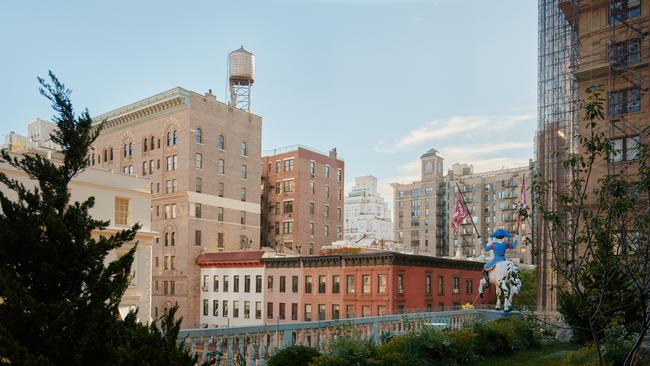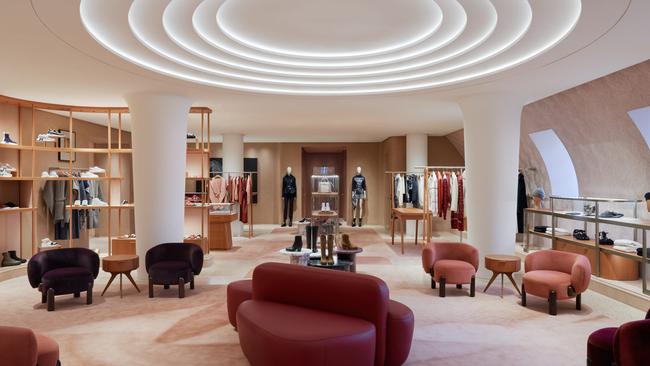Hermès Madison Avenue
New York is a tough town even for a fabled French luxury goods house. But the opening of a new store on the Upper East Side is the ultimate spur to success.

“What I like about New York City is what I don’t see,” says Pierre-Alexis Dumas, artistic director of Hermès and a sixth-generation member of the Hermès family. “I know there are great art collections here, and I would love to see the intimate New York and get into people’s homes and see these incredible places. But you don’t see them, you only see the façades.”
So Hermès did the next best thing: the French luxury goods company built its own Upper East Side mansion, complete with beautifully decorated interiors, the finest furniture, a rooftop garden and a curated collection of artworks. It also happens to be a retail store.
“I like the idea that we have created something intimate here that could be a home,” says Dumas. “Okay, it’s a store, but when you enter you cross that line from the street to the intimate and I like that tension.”
-
Discover the world’s best fashion, design, food and travel in the December issue of WISH magazine.
-
Hermès Madison is, as the name suggests, on Madison Avenue, in the heart of the Upper East Side’s luxury shopping precinct and metres from some of the city’s grandest mansions and apartment buildings. The 1880sq m store is an amalgamation of three existing buildings – two former townhouses on 63rd Street and a bank on Madison Avenue – and it was eight years in the making.
The store is staffed by 150 employees and there are 150 artworks throughout the four floors of retail space. “Never before have we worked so hard to invent, create and design a store, and the reason for that is we were building a store for New York,” says Dumas. “The expression of that was to put a lot of art on the walls in a meaningful way.

“We are obsessive collectors in the family when it comes to all sorts of things related to equestrian culture. The way we have put art throughout the store looks arbitrary, but it’s full of what I call the invisible mix, because that is what culture is about. It’s about thinking and learning, but it’s also about serendipity.”
As visitors enter the townhouse side of the store, they will discover a small Hansom cab from the 1830s that has been borrowed from the Émile Hermès collection in Paris. The store’s focal point is a stone staircase that runs all the way to the fourth floor. The 15m-high wall of the staircase acts as a vertical gallery and features a painting by the French artist Antoine Carbonne – there are also several photographs with an equine theme, as well as reproductions of Hermès scarf designs. For the opening of the store, the Brooklyn-based artist Mike Perry was commission to create colourful and kinetic window displays. A wall on the fourth floor was designed from ink drawings by the French artist François Houtin, whose work was also the inspiration for the rooftop garden created by landscape designer Miranda Brooks.
The store was designed by the architectural firm RDAI, which was founded by Rena Dumas, Pierre-Alexis’s mother (his father, Jean-Louis Dumas, was the CEO and artistic director of Hermès from 1978-2006) and designs all Hermès stores. Today the design firm is led by Denis Montel. Far from taking a cookie-cutter approach to its network of stores around the world, RDAI links every project to its specific location. The design of Hermès Madison draws upon New York’s past, and takes subtle cues from the Art Deco period and the earliest Manhattan skyscrapers.

The interior is decidedly anti-minimal. The store is arranged as a series of salons, each with its own distinctive aesthetic. “The project was almost like designing five stores in one,” says Montel. “There are many stories, but they are linked together. You go from one surprise to another.”
Throughout the store, which is flooded with natural light, there is a mix of materials, including terrazzo, stucco, straw marquetry, various wood finishes, leather, wallpaper and plush carpeting. The colour palette of the interior intensifies as you progress through the building, from light creams and beiges to green tones, dark browns, deep reds and dusty pinks. The ground floor houses silk, leather goods and equestrian products; on the second floor is the men’s universe and homewares; on the third floor is women’s wear, with more leather goods on the fourth floor. There is a coffee bar on the ground floor, and bars on the third and fourth floors. Five artisans from different métiers of the house occupy a fifth-floor atelier to handle repairs and customisation of products.
“I’ve always been challenged in New York. And I like that stimulation. In order to progress you’ve got to work hard”
“New York is a dream for Parisians,” says Dumas. “It’s always been an inspiration and a gateway. New York fulfils the fantasy of Parisians of being hyper-contemporary and up to date. It still has that aura of a city that is ever changing. It’s always been fascinating for us Europeans as a modern and dynamic city, and maybe that’s an ideal and not the reality, but ideals are there to guide us after all. Maybe it’s just the dream of a city – one that has enough energy to reinvent itself over and over again.”
Hermès was founded in Paris in 1837 and opened its first independent store in New York on East 53rd street in 1930. It closed the following year, shaken by the Great Depression. The company returned to New York in the 1950s with concessions in department stores and since the 1970s has operated independent stores all over the country (today Hermès has more than 300 stores in 45 countries). At the end of the third quarter of 2022, the Hermès Group’s revenue was up 30 per cent year on year to €8.6 billion. Sales in the US in the same period grew by 28 per cent.
In 2001, Hermès opened a flagship New York store on Madison Avenue, not far from its new location, designed by Rena Dumas. At the opening of the new Hermès Madison Avenue store, which replaces two stores on opposite sides of the street, Dumas said he was both excited and slightly melancholy. “That store had been designed by my mother and it was the peak of my father’s career, so it was a great moment. This store is really the end of a very long process and it’s quite emotional for me.”
Hermès is one of the oldest family owned and controlled companies in France and it hovers slightly above – and apart from – other luxury brands. Nevertheless, New York is still a market that can make or break even the greatest luxury houses. “New Yorkers are quite demanding,” says Dumas, who is a graduate of Brown University. “You’ve got to deliver what you say you’re going to deliver. They say to you, why should I buy your product? What’s so special about you? What’s so special about your handbag? What’s so special about your scarf? I’ve always been challenged in New York. And I like that stimulation. In order to progress you’ve got to work hard. In a strange way, the more demanding, the higher the expectation and the better the creative response. Sometimes you wish things were easier, but it’s true that if you have strong constraints it stimulates the mind.”

The design of Hermès Madison represents a shift in the way the company approaches its stores that started with its flagship in Sydney’s historic Trust building, opened in 2020. “When it came to that store, we reflected on the fact that we need to express more of our culture, the Hermès culture, in our stores,” says Dumas. “There is a lot of competition out there and we don’t like to be assimilated to everybody else. We are different and we need to express that, so we really made a conscious decision to create more intimacy in the stores and to be more expressive with the materials we use. We also decided to put a lot more art on the walls so that each store really has a lot of character, and it reflects the local culture while it also reflects the culture of Hermès.”
At a press conference for the opening of Hermès Madison in September, Dumas called the store “the real home of Hermès in the States with this building”. As well as a store in the Meatpacking district, the company has one downtown near Wall Street.
It’s also not the first time Hermès has planted roots in the Big Apple and declared it the definitive New York store. “That’s retail,” says Dumas. “It’s a strange thing that in a city like New York how the mood of a neighbourhood and where people like to shop changes. I like that, because at the end of the day there is something that you cannot control. If we control everything it’s quite scary and I like the fact that there is some anomaly in the city, that there is something organic.”


To join the conversation, please log in. Don't have an account? Register
Join the conversation, you are commenting as Logout